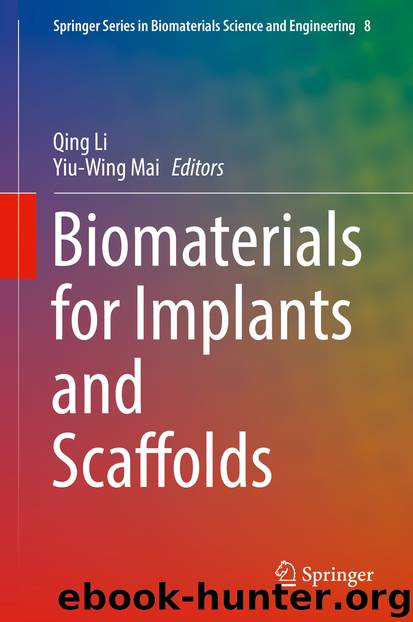Biomaterials for Implants and Scaffolds by Qing Li & Yiu-Wing Mai

Author:Qing Li & Yiu-Wing Mai
Language: eng
Format: epub
Publisher: Springer Berlin Heidelberg, Berlin, Heidelberg
Keywords
ElectrospinningScaffoldsModificationMechanical propertiesBiomedical applications
8.1 Introduction
Electrospinning is a simple, relatively efficient technique to fabricate polymer fibrous scaffolds with diameters ranging from several nanometres to several micrometres [1, 2]. The electrospun fibrous scaffolds have extraordinary high surface area-to-volume ratio and high porosity with excellent pore interconnection and have been widely used in a range of hi-tech fields, such as filtration [3], sensors [4, 5], protective clothes and biomaterial applications [6–9].
Electrospinning was first introduced by Formhals in 1934 as a patent [10] and later revived by Reneker’s groups [11–16]. They studied the electrospinning process for a series of different polymers and demonstrated the mechanism for the formation of electrospun polymer fibres. A basic theory of electrospinning is utilising electrostatic forces of highly charged polymer jets to produce continuous fibres after solvent evaporation in spinning process. A typical electrospinning set-up, as shown in Fig. 8.1, usually consists of three major components: a high-voltage power supply, a nozzle and a grounded collecting plate (usually a metal screen, plate or rotating mandrel). Upon applying an electric field, the polymer solution with a moderate viscosity forms the Taylor cone at the tip of an injecting device. When the electric voltage applied between the injector and the collector exceeds the surface tension force of the Taylor cone, the charged jets are eventually drawn towards the collecting plate. During the travel of the fibrous jets, the solvent in the jet stream gradually evaporates, generating a solidified non-woven fibrous scaffold. The morphological structure and surface properties of electrospun fibres depend on the physical parameters of the polymer solution (e.g. concentration, viscosity, conductivity and surface tension) as well as the spinning process conditions (e.g. applied voltage, distance between capillary tip and collection screen, temperature and humidity of the ambient environment) [14, 17, 18].
Fig. 8.1Scheme for electrospinning apparatus
Download
This site does not store any files on its server. We only index and link to content provided by other sites. Please contact the content providers to delete copyright contents if any and email us, we'll remove relevant links or contents immediately.
Sapiens: A Brief History of Humankind by Yuval Noah Harari(13984)
The Tidewater Tales by John Barth(12391)
Mastermind: How to Think Like Sherlock Holmes by Maria Konnikova(6936)
Do No Harm Stories of Life, Death and Brain Surgery by Henry Marsh(6683)
The Thirst by Nesbo Jo(6432)
Why We Sleep: Unlocking the Power of Sleep and Dreams by Matthew Walker(6350)
Life 3.0: Being Human in the Age of Artificial Intelligence by Tegmark Max(5182)
Sapiens by Yuval Noah Harari(5118)
The Longevity Diet by Valter Longo(4856)
The Body: A Guide for Occupants by Bill Bryson(4579)
The Rules Do Not Apply by Ariel Levy(4521)
The Immortal Life of Henrietta Lacks by Rebecca Skloot(4249)
Why We Sleep by Matthew Walker(4190)
Animal Frequency by Melissa Alvarez(4148)
Yoga Anatomy by Kaminoff Leslie(4100)
The Hacking of the American Mind by Robert H. Lustig(4082)
All Creatures Great and Small by James Herriot(3980)
Barron's AP Biology by Goldberg M.S. Deborah T(3943)
Double Down (Diary of a Wimpy Kid Book 11) by Jeff Kinney(3922)
